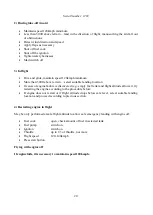
Serial Number: 1203
12
2.5
Brief technical description
Characteristic
The Legend ultralight aircraft is a two-seat, strut high-wing monoplane of all-composite structure
designed for sport, recreational or tourist flying. Favourable flight characteristics make the aircraft
suitable for flight training. Sufficient performance allows glider towing. The aircraft features
spacious crew and baggage compartments. Large doors provide for comfortable boarding of crew
and loading of baggage. Adjustable seats allow the pilots of all heights to find comfortable position.
A stiff Kevlar cabin, four-point seat harnesses and rocket assisted rescue system provide maximum
safety of crew in emergency situations.
Technical description of aircraft components
A) Airframe
1.
The fuselage is made of carbon composite. Bulkheads are bonded into integrally stiffened
skin to receive forces from the landing gear, rescue system, stabilizer, rudder, safety harnesses, and
wings. There are two doors with a central-lock system mounted on flush hinges on the sides of
fuselage, opening against flight direction.
2.
Sandwich-type single-spar wings made of carbon-composite house two fuel tanks within
leading section. Wings are fitted with a slotted Fowler flaps. Wings have rectangular centre section
with trapezoidal tips. MS 313 wing profile is used. Banking control by ailerons with differentiated
deflection 10° down and 23° up . With aileron deflection up, a nose rises from profile, providing
favourable yawing moment. The wing strut is made of aluminium profile.
3.
Trapezoidal fixed part of elevator is fixed into the fuselage bulkheads by pins and screws.
Aerodynamically balanced elevator has electrically servo-actuated trim tab. The elevator deflection
is 21° up and 13° down.
4.
Fixed part of trapezoidal swept vertical tail is offset from a longitudinal axis to eliminate an
angular propeller flow. The elevator deflection is approximately 24°.
5.
Rudder and ailerons have dual cable control, elevator is rod-operated. Yoke controls. Rudder
and nose landing gear are operated by pedals with top-mounted shafts, which greatly improves the
kinematics of controls. Combined central controller allows control of the engine, landing gear
brakes, parking brake, and wing flaps, the flaps being driven by central actuator through Bowden
cables.
6.
Tricycle landing gear with steerable nose wheel. Main wheels – size 15x6-6 - are provided
with hydraulic disc brakes. Amortization by composite legs. The nose wheel fitted with spring and
hydraulic shock absorber. The front wheel has size 12 x 4 – 4. All wheels provided with fairings.
Tire inflation of all wheels is for 2,3 bar pressure.
B) Powerplants
Rotax 912 and 912S engines are used most frequently, providing excellent dynamic and flight
characteristics. Rotax 912 and 912S engines are four-stroke, four-cylinder engines of “boxer”
configuration, having air-cooled cylinders with water-cooled heads, integrated reduction gearbox,
and two carburetors. For more information, see the engine instructions for use.













































